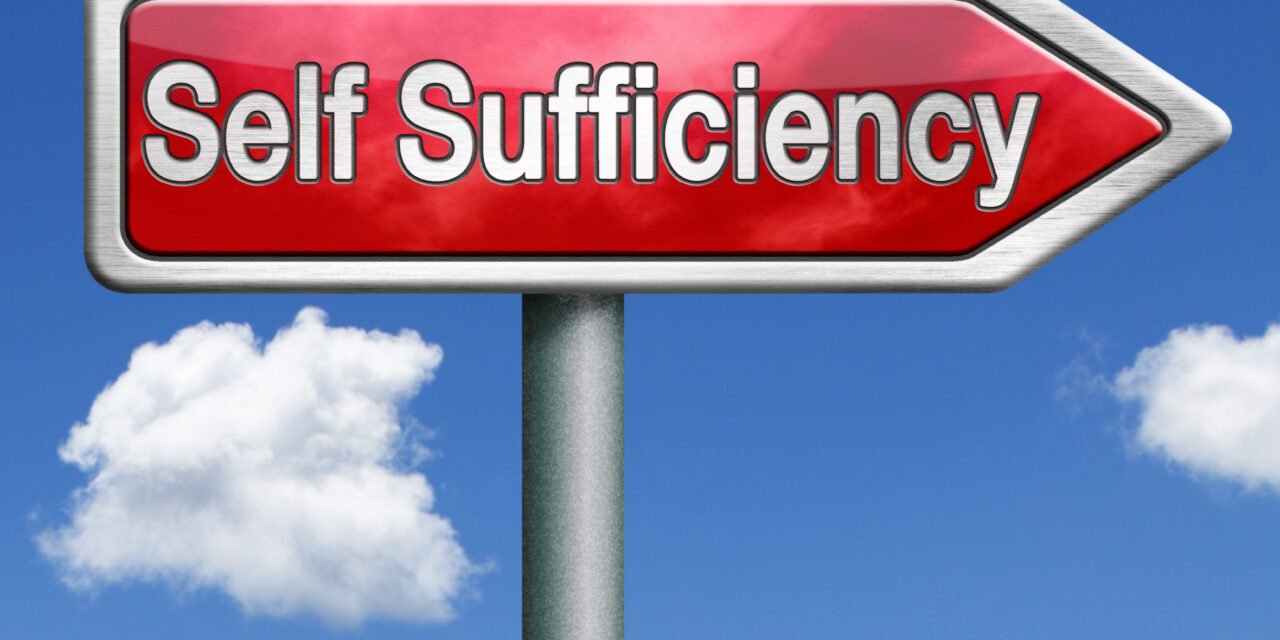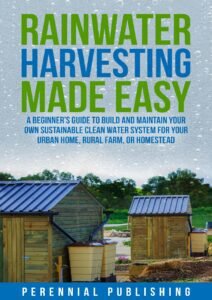In today’s society, becoming self-sufficient seems almost impossible. The world is deeply interconnected and technology-driven. We rely on global supply chains for everything from food to electronics. Even if I grow my own vegetables and generate my own electricity, I still need seeds, tools, and maintenance for solar panels. Most of us lack the skills and resources to handle all our needs alone. While we can reduce dependence and be more self-reliant, true self-sufficiency is a lofty dream – So in this post we ask is it even possible to be self sufficient?
Post Contents
ToggleUnderstanding Self-Sufficiency
Self-sufficiency means being able to live in a way that doesn’t rely too much on outside sources. This is about producing what we need, like food, energy, and water, within our own means. It’s about creating a life where we are in control and independent from public utilities and services.
Principles of Self-Sufficiency
The main principles of self-sufficiency revolve around independence, minimalism, and sustainability. Here’s a closer look at each:
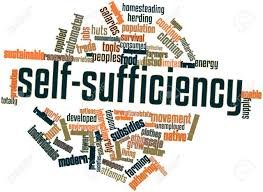
Independence: This principle is about reducing dependence on external suppliers. Whether it’s growing your own food, generating your own energy, or having your own water supply, the goal is self-reliance. Independence gives you peace of mind and security, knowing you can take care of yourself and your family under any circumstances.
Minimalism: Living with fewer things can make self-sufficiency much simpler. Minimalism encourages us to focus on what’s really necessary and valuable, cutting out excess materials and unnecessary luxuries. This can lead to a clearer, more focused lifestyle that’s easier to maintain off the grid.
Sustainability: Sustainability involves actions that do not deplete resources or harm the environment. This principle ensures that your off-grid lifestyle can be maintained for years to come without negatively impacting the planet. Sustainable practices include using renewable energy sources like solar or wind, practising water conservation, and growing organic food.
For more on these principles, you can check out Positive Psychology’s guide on developing self-reliance.
Benefits of Living Off the Grid
Living off the grid comes with many benefits that improve your quality of life. Some key benefits include:
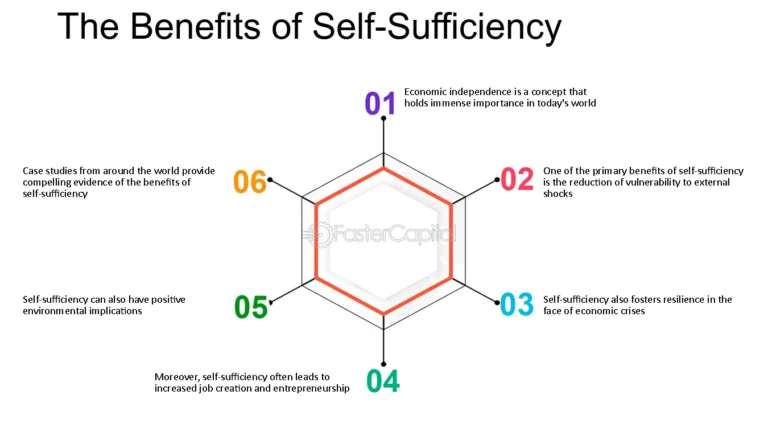
Cost Savings: By producing your own energy, growing your own food, and reusing materials, you can save a lot of money. You avoid utility bills and reduce living expenses significantly. In the long run, an off-grid lifestyle can be very economical.
Environmental Impact: Living off the grid often means a smaller carbon footprint. With renewable energy sources and sustainable practices, you contribute to a healthier planet. This eco-friendly lifestyle can be very rewarding, knowing you’re doing your part to protect the environment.
Personal Freedom: One of the biggest benefits is the sense of freedom it provides. You are no longer tied to the schedules and rules of utilities and public services. This autonomy allows for a very flexible, tailored way of living. For a deeper understanding, see Econation’s insights on the benefits of self-sufficiency.
Understanding these principles and benefits can guide you towards a more self-sufficient and fulfilling lifestyle. Living off the grid isn’t just about survival; it’s about thriving independently, sustainably, and with a renewed sense of freedom.
Choosing the Right Location
Selecting the ideal place for your off-grid lifestyle is a crucial step. The location you choose will impact not just your daily life but your overall success in achieving self-sufficiency. Here’s what you need to look out for:
Evaluating Climate and Weather
When considering a location, the climate and weather patterns play a significant role. You want to ensure that the area you select suits your comfort level and supports sustainable living. Here’s what to consider:
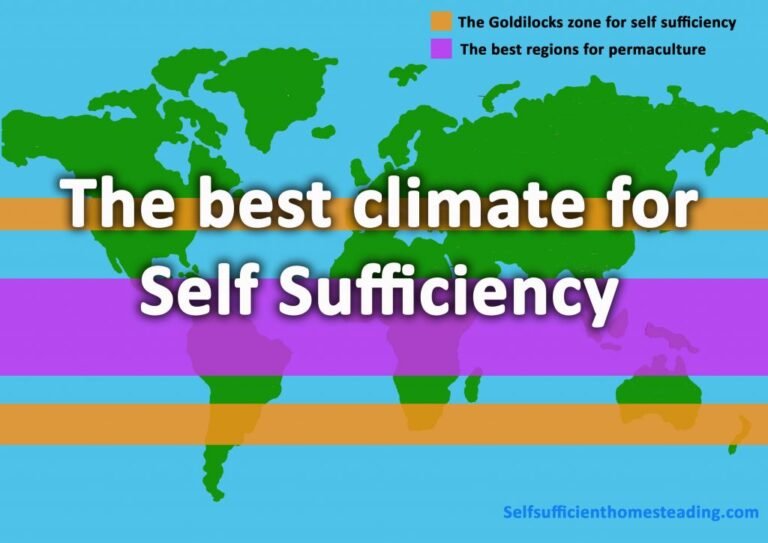
Temperature ranges: Think about your tolerance for extreme temperatures. Will you be comfortable handling the sweltering heat of the south or the biting cold of the north?
Rainfall: Water is essential, so tracking the average yearly rainfall can help ensure a reliable water source. Some areas have long dry seasons, impacting water collection and storage.
Seasonal changes: Understand the length and severity of seasons. Areas with four distinct seasons may offer varied growing periods and require robust preparation for winter.
For an assessment of the best climates for off-grid living, you might find this detailed guide on selecting climate helpful.
Access to Natural Resources
Resources like water, fertile soil, and sunlight are indispensable for sustainable living. A thorough examination of your potential location’s natural resources is necessary.
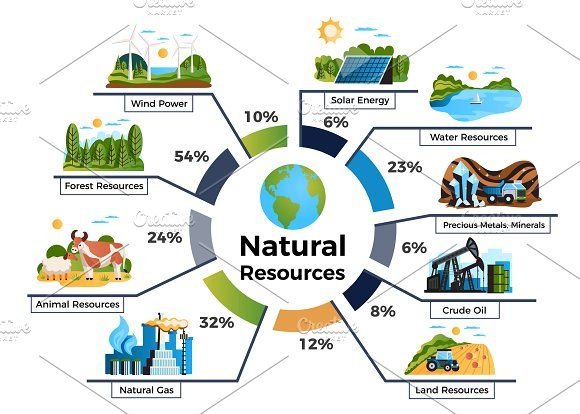
Water Sources: Evaluate the availability of freshwater sources like rivers, lakes, and aquifers. Reliable access to water is vital for drinking, irrigation, and personal use.
Soil Quality: Conduct soil tests to determine its suitability for farming. Rich, fertile soil can make a huge difference in growing your own food.
Sunlight and Wind: For those relying on renewable energy, locations with high solar or wind potential are ideal. Make sure the conditions align with your energy production plans.
You can explore this insightful article on resource assessment for more information.
Legal Considerations With Self Sufficiency UK
Living off the grid in the UK comes with its own set of legal challenges. Before making the shift, you need to check local planning laws. Councils have strict rules on land use and building structures. If you want solar panels or a wind turbine, you’d best get planning permission first. Water rights can also be tricky; collecting rainwater isn’t always allowed without a permit. Waste disposal is another crucial part; improper handling can lead to hefty fines. Ignoring these regulations can result in legal trouble and financial penalties. So, it’s essential to navigate these rules carefully for a smooth transition.
Planning Laws: These dictate what activities are permissible on your land. Ensure your chosen plot allows for residential use, agriculture, and other self-sufficiency tasks.
Building Codes: Compliance with local building codes is mandatory. These regulations cover everything from home construction to sewage systems.
Permits: Some areas require special permits for activities like water-well drilling, solar panel installation, or building additional structures.
A thorough legal check is necessary. Learn more about navigating off-grid regulations in this comprehensive guide.
By carefully evaluating these factors, you’ll be better prepared to choose a location that supports your off-grid lifestyle, ensuring a smooth path to self-sufficiency.
Building Your Off-Grid Home For Self Sufficiency
When it comes to living off the grid, your home is your castle and sanctuary. Building an off-grid home involves careful planning and smart choices to create an energy-efficient and sustainable living space. Here’s how you can build your off-grid home:
Sustainable Building Materials
Using eco-friendly materials for your construction project is not only good for the environment but can also enhance the sustainability of your home. Here’s a list of sustainable building materials suitable for off-grid construction:
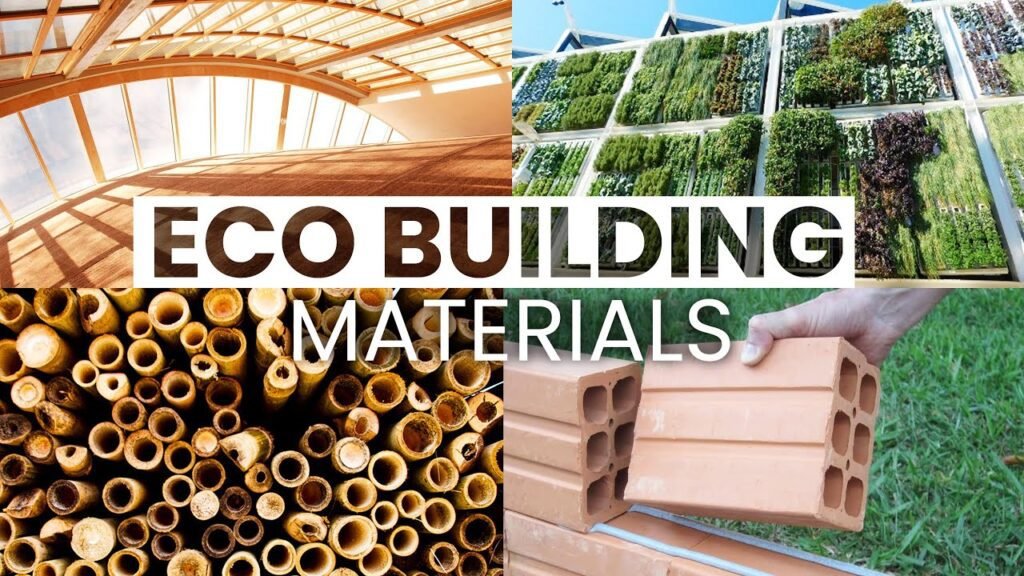
Recycled Wood: This includes reclaimed wood from old buildings, barns, and factories. It’s not only durable but adds a rustic charm to your home.
Bamboo: Known for its fast growth and strength, bamboo is a green material that’s ideal for both structural and decorative elements.
Straw Bales: These can be used for insulation or as the primary building material. Straw bales offer excellent thermal mass, keeping homes warm in winter and cool in summer.
Earth: Adobe, cob, and rammed earth are traditional building methods using natural soil. These techniques create homes with great thermal properties that blend seamlessly with their surroundings.
Insulated Concrete Forms (ICFs): These are blocks or panels made of rigid foam that can be stacked to form the shape of your walls. They are filled with concrete, providing strong, energy-efficient, and disaster-resistant homes.
Using these materials ensure that your home is built to withstand the test of time while retaining its eco-friendly footprint. For more details on sustainable materials, you can check out Ecohome’s guide.
Energy-Efficient Design
Maximizing energy efficiency in your off-grid home is essential for a sustainable lifestyle. Here’s how you can achieve that through smart design:
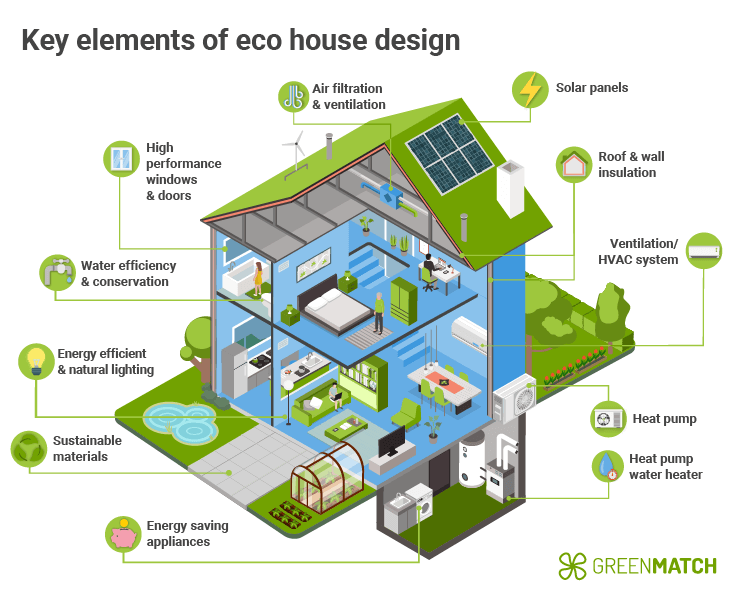
Passive Solar Design: This involves orienting your home to take advantage of the sun’s energy without reliance on mechanical systems. Large, south-facing windows will let in natural light and warmth during the winter months.
Thermal Mass: Use materials like concrete, brick, or tile in your interiors; they absorb heat during the day and release it at night, helping to maintain a steady indoor temperature.
Proper Insulation: Insulating your home’s walls, roof, and floors will reduce the need for additional heating and cooling, making your home more energy-efficient. Double-glazing your windows can further enhance this effect.
Green roofs: Cover your roof with plants to improve insulation and reduce rainwater runoff. Green roofs also provide habitats for wildlife and can grow food.
Natural Ventilation: Design your home to maximise natural air flow. Place operable windows, vents, or roof ventilators strategically to ensure good air circulation, which helps in cooling during hotter periods.
Implementing these strategies will ensure your home remains comfortable year-round while reducing your dependence on external energy sources. If you want to dive deeper into energy-efficient home design, have a look at this informative resource.
Generating Your Own Power For Self Sufficiency
Living off the grid means you need to generate your own power. Thankfully, there are several ways to do this, each with its own set of benefits and challenges. I’ll walk you through the main methods including solar power systems, wind turbines, and hydroelectric power.
Solar Power Systems
Setting up a solar power system for your off-grid home is one of the most popular and effective choices. Solar panels convert sunlight into electricity which can then be stored in batteries for use when the sun isn’t shining.
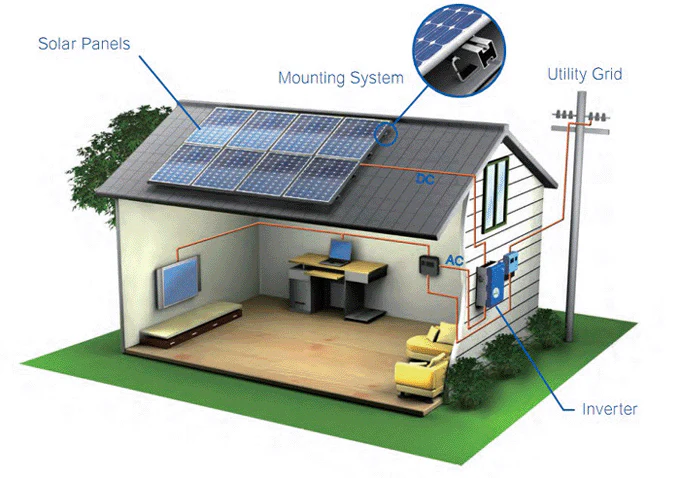
Steps to Set Up a Solar Power System:
- Assess Energy Needs: Calculate your household’s average daily energy consumption in kilowatt-hours (kWh).
- Select Solar Panels: Choose the right type of solar panels based on efficiency and cost. Monocrystalline panels are highly efficient but more expensive, while polycrystalline panels are more affordable but less efficient.
- Install Panels: Mount the solar panels on a roof or standalone frame where they can receive maximum sunlight. The ideal angle and positioning depend on your location. South-facing panels are generally optimal.
- Add a Battery Storage System: Install deep-cycle batteries to store the energy generated for use during nighttime or cloudy days.
- Include a Charge Controller: This protects your batteries from overcharging by regulating the flow of electricity.
- Inverter Installation: An inverter converts the DC electricity stored in your batteries to AC electricity for your home’s appliances.
Maintenance Tips:
- Regular Cleaning: Dust and debris can reduce efficiency. Clean panels periodically using a soft brush or sponge and water.
- Monitor System Performance: Check the charge controllers and batteries regularly to ensure they are functioning correctly.
- Professional Inspections: Occasionally have a professional assess your system to keep it in top shape.
Here’s a comprehensive guide to solar power for your off-grid house.
Wind Turbines
Wind turbines are another good option for generating off-grid power. They convert the kinetic energy from wind into electricity. This method works best in areas with consistent, strong winds.
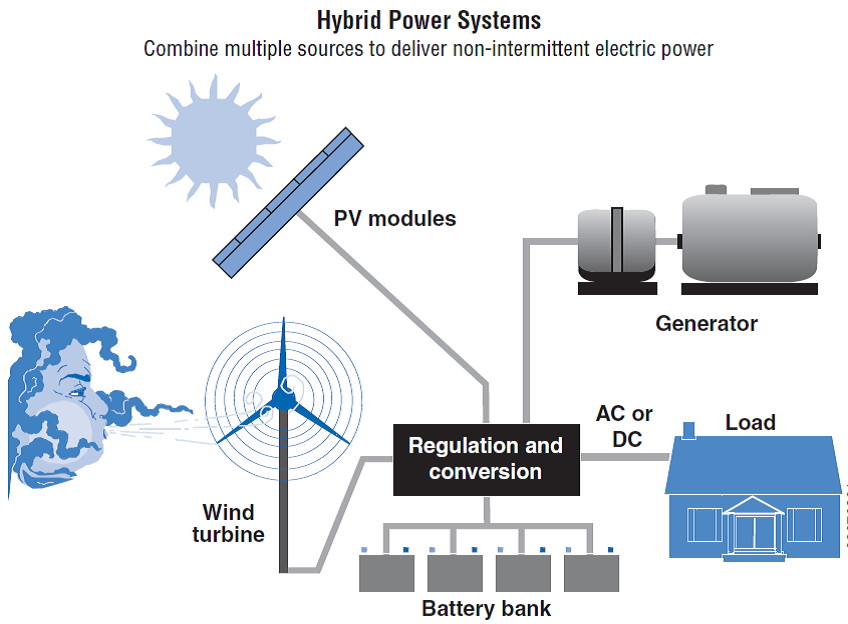
Benefits of Wind Turbines:
- Sustainable Energy Source: Wind is a renewable resource, making it an eco-friendly way to generate power.
- Cost-effective Over Time: After the initial investment, maintenance costs are relatively low.
- Supplemental Power: Wind turbines can complement solar power, providing electricity during cloudy or nighttime periods.
Challenges:
- Site Requirement: Wind turbines require open spaces free from obstacles and sufficient wind speeds (typically above 10 mph).
- Noise and Aesthetics: They can be noisy and are sometimes seen as visually unappealing.
- Wildlife Impact: Can pose risks to birds and other wildlife.
Setup involves these steps:
- Wind Assessment: Measure wind speed and patterns at your location over time to determine feasibility.
- Choose a Turbine: Depending on your energy needs, you can select small turbines for straightforward jobs or larger ones for more power.
- Install Mast and Turbine: Mount the turbine on a high mast to capture the most wind possible.
- Connect to Batteries/Inverter: Just as with solar power systems, add batteries and an inverter system to store and convert the generated electricity.
For more information on wind turbines, refer to this practical guide to off-grid energy solutions.
Hydro-electric Power
Hydroelectric power harnesses the energy from flowing or falling water to generate electricity. It’s a viable option if your property includes a river or stream with significant flow.
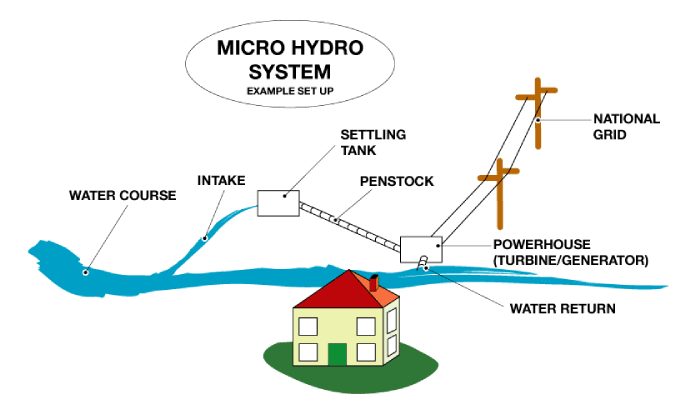
How to Harness Hydroelectric Power:
- Identify Water Source: Evaluate the flow rate and drop height (also known as head) of your water source. The greater the flow and head, the more power.
- Select Hydro-electric System: Depending on the scale, systems range from micro-hydro setups producing a few kW to larger installations.
- Install Turbine and Generator: Place the turbine in the water flow, connected to a generator to convert mechanical energy into electricity.
- Pipe Installation: Water is directed to the turbine using pipes, maximising flow efficiency.
- Battery and Inverter Setup: Connect the setup to batteries and an inverter for energy storage and usage.
Advantages:
- Consistent Power Supply: Flowing water can provide a reliable and steady supply of electricity, potentially 24/7.
- Efficient and Long-lasting: Hydroelectric systems are highly efficient and can last many years with minimal maintenance.
Challenges:
- Environmental Impact: Can affect aquatic life and water use patterns.
- Site Specificity: Limited to properties with existing water sources capable of generating power.
For detailed insights into hydroelectric systems, check out Family Handyman’s article on off-grid power systems.
This section should give you a solid grounding in the primary methods of generating your own power off the grid. By choosing the right system and maintaining it well, you can achieve true energy independence.
Water Collection and Purification Self Sufficiency
Living off the grid means finding your own dependable way to collect and purify water. Secure access to clean water is key for survival and maintaining health. Let’s explore how you can do this effectively.
Rainwater Harvesting Self Sufficiency
Rainwater harvesting is a simple, yet effective method to collect water for your off-grid home. Here, the goal is to capture and store rainwater, making it available for use at a later time. Here’s how you can get started:
Rainwater Harvesting Free ebook
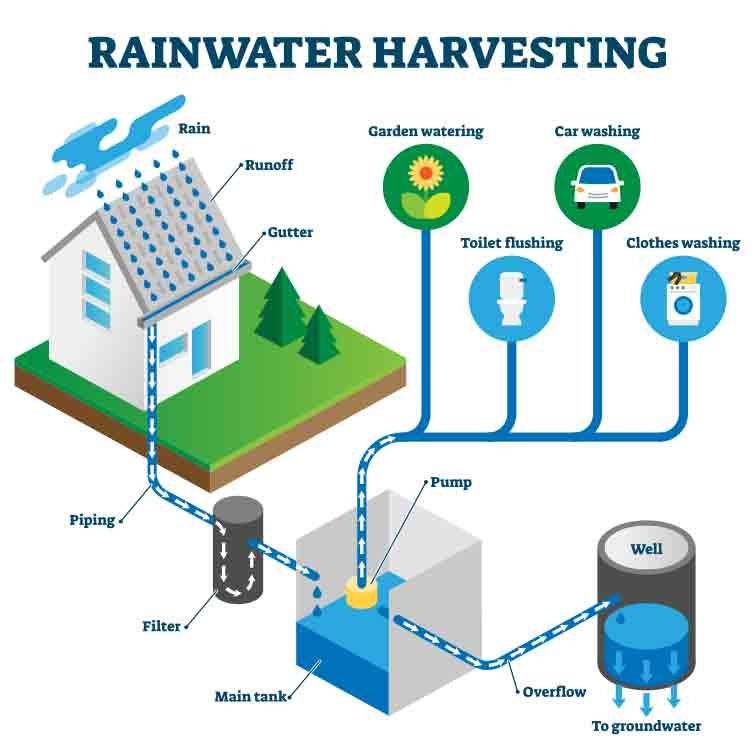
Steps to Harvest Rainwater:
- Rooftop Collection: Install gutters on your roof to channel rainwater. The roof area and slope influence how much water you’ll collect.
- Downspouts and Piping: These direct the flow from gutters into storage tanks.
- First Flush Diverter: Keeps the first flush of rainwater, which may contain debris and pollutants, from entering storage. This leaves cleaner water for you to store.
- Storage Tanks: Use large tanks to store collected water. These can be above or below ground, depending on your preference and available space.
- Screen Filters: Install filters to prevent leaves and larger debris from entering your storage.
Equipment Needed:
- Gutters and downspouts for channelling water
- First flush diverter to filter initial runoff
- Storage tanks to hold the water
- Filters to clean the water before storage
By implementing a rainwater harvesting system, you can take advantage of natural precipitation, reducing your dependence on other water sources. For more detailed information on setting up a rainwater harvesting system, check out this resource on harvesting rainwater.
Water Filtration Systems
Even if you’re harvesting rainwater, it’s crucial to purify it before use, to ensure it’s safe to drink. Several water filtration systems can cater to off-grid living. Here are some common methods:
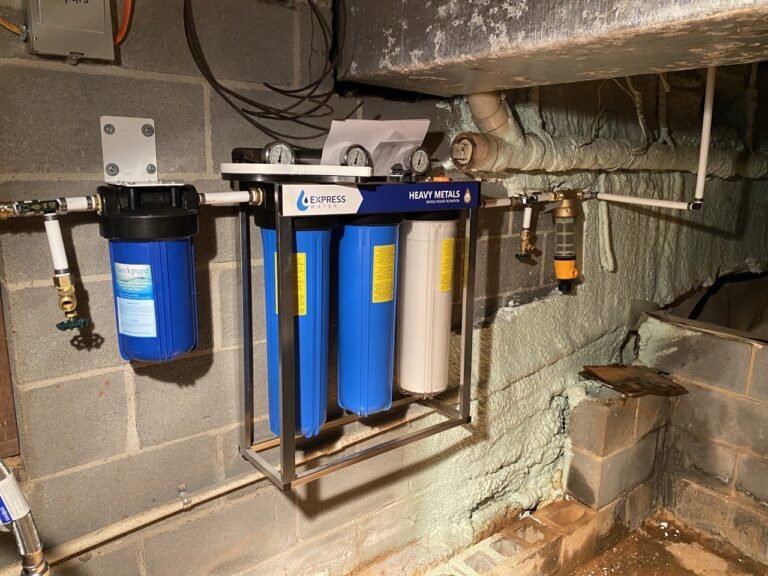
Filtration Methods:
- Boiling: Simple and highly effective. Bring water to a rolling boil for at least one minute to kill pathogens.
- Activated Carbon: Uses a filter containing activated carbon to remove impurities and contaminants. Works well for improving taste and odour.
- UV Purification: Exposes water to ultraviolet light, which destroys bacteria and viruses.
- Reverse Osmosis (RO): Forces water through a semi-permeable membrane, removing most contaminants. Efficient but needs significant water pressure.
- Ceramic Filters: Contains small pores that prevent pathogens and debris from passing through, making water safe to drink.
- DIY Filters: Combine gravel, sand, and activated charcoal in layers within a container to create a filter.
- Chemical Disinfection: Use tablets or drops containing iodine or chlorine, which can disinfect your water effectively.
Systems such as these can be combined for enhanced purification. For instance, using a ceramic filter followed by UV light treatment ensures even high levels of pathogens are removed.
Having these methods in place ensures that your water, whether sourced from rain, a stream, or a well, is safe for drinking and use. To choose the best system for you, you can refer to Aqualogic’s comprehensive guide on water purification.
By collecting rainwater and purifying it properly, you can ensure a steady supply of clean water, crucial for living off the grid. It’s a vital step toward achieving complete self-sufficiency and peace of mind in knowing your water needs are taken care of.
Be prepared and protected by understanding these methods of water collection and filtration. Go ahead and explore more about these systems, and start implementing your own solution today!
Growing Your Own Food Is A Must For Self Sufficiency
Living off the grid and achieving self-sufficiency means being able to provide your own food. You can do this through cultivating a vegetable garden and raising livestock. Both of these activities can be highly rewarding and help you live a more sustainable life.
Vegetable Gardening
Starting a vegetable garden is essential for self-sufficiency. Here are some practical tips to help you get going:
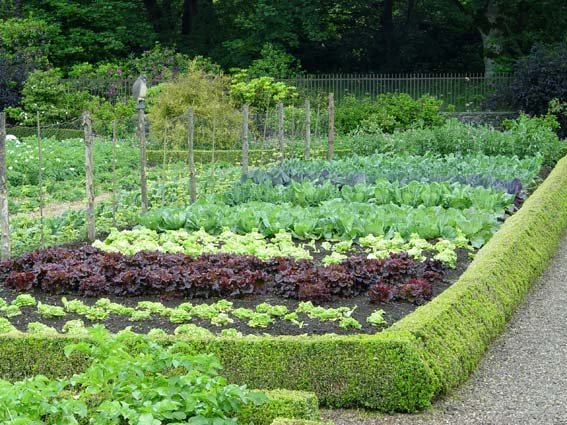
1. Choose the Right Location: Select a spot with plenty of sunlight – vegetables generally need at least six hours of direct sun each day. The soil should be well-drained, fertile, and free from harmful contaminants. Consider a raised bed if the natural soil is poor.
2. Prepare Your Soil: Good soil preparation is crucial. You might need to add compost or organic fertilizers to enrich the soil. A soil test can determine the pH and nutrient levels before you start planting. Here’s a helpful guide on sustainable soil management.
3. Plan Your Garden Layout: Organise your garden by grouping plants with similar growth requirements together. Crop rotation is essential – don’t plant the same vegetable in the same location every year. This prevents soil depletion and reduces pest issues.
4. Select the Right Vegetables: Grow vegetables that you and your family enjoy eating. Beginners often find it easier to start with crops like tomatoes, lettuce, carrots, beans, and peppers.
5. Practice Water Conservation: Utilise rainwater for irrigation and consider drip watering systems to minimise water wastage. Mulching can also help retain soil moisture and reduce weeds.
6. Maintain and Monitor: Regularly check for pests, diseases, and nutritional deficiencies. Organic pest control methods and natural disease management techniques are preferable to chemical solutions. Proper weeding and periodic soil amendments keep your garden healthy and productive.
For a step-by-step guide on starting a successful vegetable garden, check out this comprehensive resource.
Raising Livestock
Raising livestock is another critical part of becoming self-sufficient. Here’s how to get started with chickens, goats, and other animals:
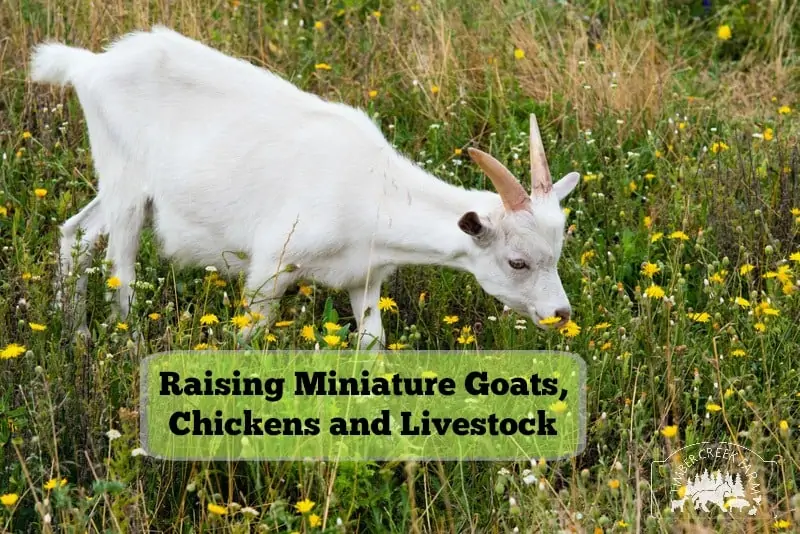
Raising Chickens: Chickens are a great choice for beginners because they’re relatively easy to care for and provide a constant supply of eggs and meat.
- Housing: Build or buy a sturdy coop that protects from predators and the weather. Include nesting boxes and perches.
- Feeding: Provide a balanced diet of grains, vegetable scraps, and access to fresh water. Allow them to forage, which helps with pest control.
- Health Care: Keep the coop clean to prevent diseases. Regularly check for lice and mites and administer vaccinations as needed.
Raising Goats: Goats can provide milk, meat, and even help you maintain your land by clearing weeds and brush.
- Shelter: A simple three-sided shelter can protect them from wind and rain. Ensure it’s dry and clean.
- Feeding: Goats love to browse, so provide plenty of brush and hay. Supplement their diet with grains and minerals.
- Health Maintenance: Regular hoof trimming and health check-ups are essential. Be on the lookout for common diseases like mastitis and enterotoxemia.
Other Livestock: Depending on your space and resources, consider raising other animals like rabbits, ducks, or pigs. Each comes with its specific needs but rewards you with valuable products like meat, fur, or eggs.
- Rabbits: Require less space, are quiet, and breed rapidly. They’re great for meat and fur. Provide hutches and a diet rich in hay and greens.
- Ducks: Hardy and excellent for egg-laying, ducks need a pond or water source. Provide shelter and a balanced diet.
- Pigs: Efficient meat producers. Housing should be sturdy, and they need a diet of grains, vegetables, and formulated feed.
For more in-depth information on raising livestock, you might find this homesteading self-sufficiency guide enlightening.
By growing your own food through gardening and keeping livestock, you’ll move closer to becoming self-sufficient. This not only provides your family with fresh, healthy produce and meats but also fosters a deeper connection with nature. Remember, every small step you take in your off-grid journey helps build a sustainable and fulfilling lifestyle.
Managing Waste
Managing waste off the grid is essential to maintain a clean and sustainable environment. It’s about making the best use of resources while reducing our impact on the planet. The two key methods are composting and recycling and reusing.
Composting:
Composting is a fantastic way to recycle your organic waste. It allows you to turn kitchen scraps and garden waste into nutrient-rich soil conditioner. Here’s how to set up your composting system:
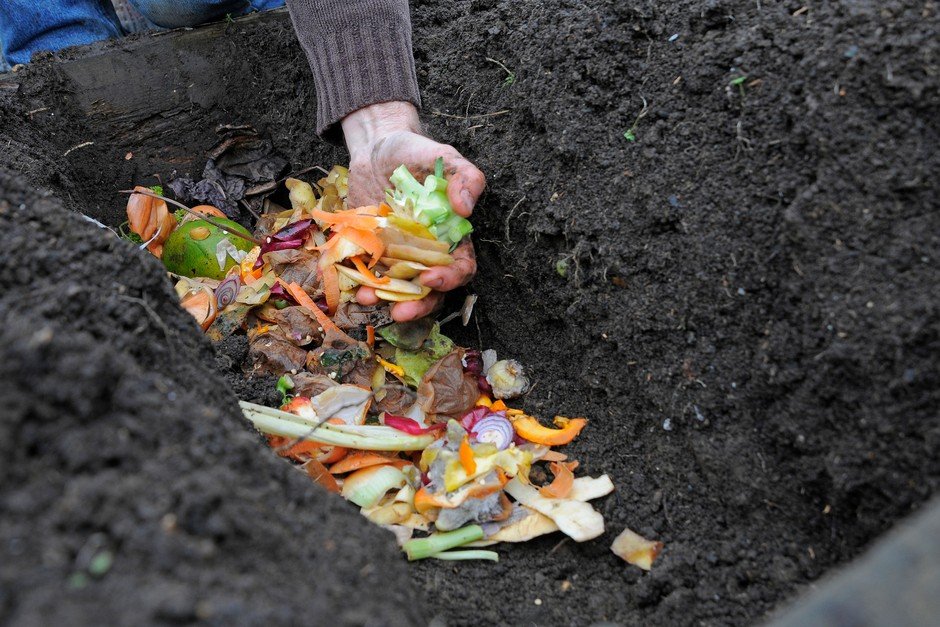
Choose a Location: Find a suitable spot for your compost heap or bin. It should be easily accessible, level, and have good drainage.
Select a Compost Bin: You can buy a compost bin or make your own. There are various types such as tumblers, stackable bins, or simple piles. Make sure it allows for good airflow and retains moisture.
Know What to Compost: Compostable materials fall into two categories:
- Greens: These are kitchen scraps like vegetable peels, fruit waste, coffee grounds, and grass clippings. They add nitrogen to the compost.
- Browns: These include dry leaves, cardboard, paper, and wood chips. They provide carbon.
A good compost needs a balance – roughly equal parts of greens and browns.
Layer the Materials: Start with a layer of browns, then add greens on top. Continue layering, mixing periodically with a shovel to improve aeration.
Maintain the Pile: Your compost pile needs to be moist, similar to a damp sponge. Water it if it’s too dry and cover if it’s too wet. Turn the pile every few weeks to introduce oxygen, aiding the decomposition process.
Harvest the Compost: After several months, the bottom layer of the pile will turn into rich, dark compost. Remove it and use it to enrich your garden soil.
For more detailed information on composting, you can refer to this guide from UMass Extension.
Re-cycling and Re-using:
Recycling and reusing materials can dramatically reduce the waste your household produces. Here are some practical tips to help you implement these practices effectively:
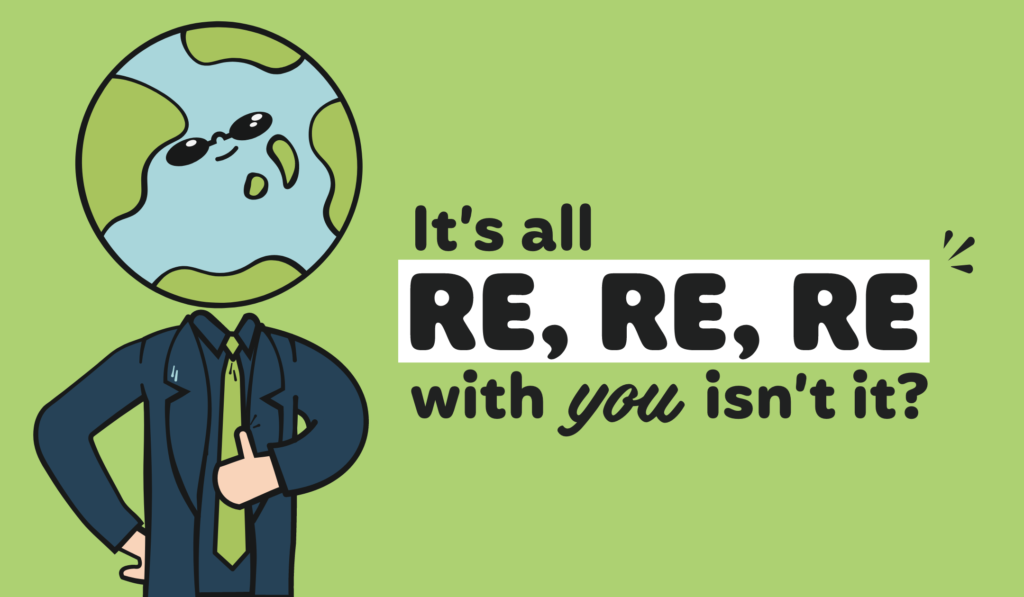
Separate Your Waste: Have designated bins for different types of waste: paper, plastics, glass, metals, and non-recyclables. This makes recycling much easier.
Clean and Store Recyclables: Rinse containers to remove food residue before recycling. Store them properly until you have enough to take to the recycling centre.
Know Your Local Recycling Rules: Different areas have different rules about what can and cannot be recycled. Make sure you understand your local regulations.
Repurpose Items: Before throwing things away, think about how they could be repurposed. Glass jars can be reused for storage, old clothes can become rags, and broken furniture can sometimes be fixed or reworked.
DIY Projects: Consider engaging in DIY projects with items you might otherwise discard. For example:
- Old Tyres: Convert them into planters or swings.
- Wood Pallets: Transform into furniture or garden beds.
Compost Other Yard Waste: Besides food scraps, many yard wastes like leaves, twigs, and grass clippings can also be composted. This reduces the amount of waste that needs to be disposed of.
Donate Unwanted Items: Items still in good condition, such as clothing, electronics, or toys, can be donated to charities or sold at a garage sale.
Incorporating these recycling and reusing strategies into your daily life can not only reduce waste but also save money and resources. For more information on sustainable waste management, check out this guide from Recycle Track Systems.
By adopting composting and recycling practices, you’ll be significantly reducing your household waste and contributing to a more sustainable lifestyle off the grid. These small steps lead to big changes, ensuring you live efficiently and eco-consciously.
Conclusion
Living off the grid embodies the true essence of self-sufficiency, focusing on independence, sustainability, and fulfilling an autonomous lifestyle. By understanding and implementing the principles discussed, you can create a rewarding off-grid experience. Start by choosing the right location, building a sustainable home, generating your own power, securing water, growing your food, and managing waste efficiently.
Take the first steps towards embracing self-sufficiency and living off the grid. It’s a journey that not only fosters resilience but also connects you fundamentally to the land and your well-being. You have the knowledge and now, the encouragement to begin. Let’s bring this vision to life and reclaim control over our lifestyles, sustainably and independently.

